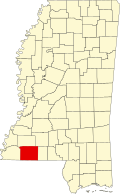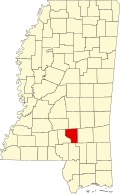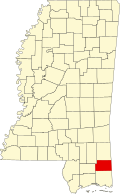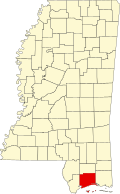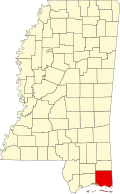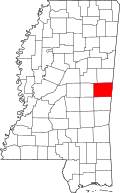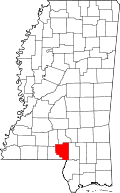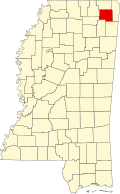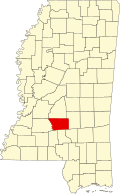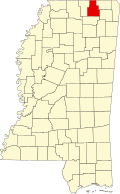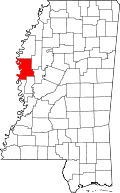| Counties of Mississippi | |
|---|---|
| Location | State of Mississippi |
| Number | 82 |
| Populations | Greatest: 213,730 (Harrison) Least: 1,295 (Issaquena) Average: 35,891 (2024) |
| Areas | Largest: 933.9 square miles (2,419 km2) (Yazoo, by land) Smallest: 401.3 square miles (1,039 km2) (Alcorn) Average: 591 square miles (1,530 km2) |
| Government | |
| Subdivisions |
|
The U.S. state of Mississippi has 82 counties. The first two counties, Adams County and Pickering County (renamed Jefferson County later), were established in 1799 in the Mississippi Territory. [1] 14 counties, all in the southwest, were created before the Mississippi Territory became a state in 1817. [1] The last county created was Humphreys County in 1918. [2] The Mississippi Constitution governs the creation of new counties, which requires an election of qualified electors to approve of the creation of a new county. Elections are limited to once every four years. Any new county must be at least 400 square miles (1,000 km2), with no existing county reduced below that size. [2]
Contents
The county governing body, known as the Board of Supervisors, is located under the judicial branch of state government as established in the 1817 Mississippi Constitution. [3] The 1868 Constitution mandated five-member Board of Supervisors, an evolution of the five-member board of police created in the 1832 Constitution. [2] Supervisors are elected without term limits. County government includes other elected and appointed officials who serve concurrent four-year terms. Major elected officials include the chancery clerk, who manages records and administrative tasks for the supervisors and chancery court; the circuit clerk, who handles election administration duties; and the sheriff, who functions as the chief of county law enforcement. Other elected officials include the constables, justice court judges, and the tax assessor or collector (23 counties have separate officials). [4] [5] Major appointed county officials include the board attorney, the county administrator, the county engineer, and the road manager. [5] Counties have either one of two county seats, depending on the number of court districts. [6] [5]
Through evolving constitutions, counties are granted police powers, administrative duties for transportation infrastructure, and election scheduling for vacacines in county offices. The Board of Supervisors are mandated to additional duties as defined by the legislature. While placed under the judicial branch, the Mississippi Supreme Court recognize counties perform mixed duties that are executive, legislative, and judicial in nature. [2] Prior to 1988, each supervisor independently managed roads and bridges in their assigned area, and would allocate money at their discretion, subject to restrictions in state law. County revenues were divided equally among all five supervisors. However, this came under scrutiny after Operation Pretense (1984–1987), an FBI sting operation targeting corruption that led to the indictment of fifty-five county supervisors. The Mississippi Legislature passed the County Government Reorganization Act of 1988 in response, which transferred responsibilities to a system of centralized road administration. [5]
According to 2024 U.S. census Data, the average population of Mississippi's 82 counties is 35,891, with Harrison County as the most populous (213,730) and Issaquena County the least (1,295). Six counties have populations over 100,000 while 15 have populations under 10,000. [7] Yazoo County is the largest by total area at 933.9 square miles (2,419 km2), and Alcorn County is the smallest at 401.3 square miles (1,039 km2). [8] The average land area is 591 square miles (1,530 km2). [7] 19 counties have names with Native American etymologies. [9]
The Federal Information Processing Standard (FIPS) code is used by the United States Federal government to uniquely identify counties. In the table below, each code links to the U.S. Census "quick facts" page for that county. Mississippi's FIPS state code is 28.


